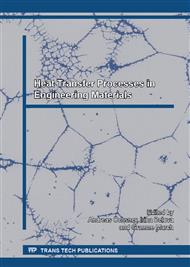p.103
p.111
p.121
p.129
p.135
p.147
p.159
p.169
p.185
Sensitivity of Models Applied in Selected Simulation Systems with Respect to Database Quality for Resolving of Casting Problems
Abstract:
This paper highlights permanent development of process virtualization in the mechanical engineering industry, especially in the area of foundry. Virtualization is increasingly developed on the stage of product design and materials technologies optimization. Simultaneously, increasing expectations of design and process engineers regarding the practical effectiveness of applied simulation systems is observed. To enhance the knowledge in the scope of modelling and simulation in the foundry processes, one should be acquainted with the hard modelling based on physical-mathematical formula and also the soft modelling, burdened with simplifications resulting from both knowledge level on description of particular phenomena and level of theirs complexity. The trends observed in modelling of foundry processes and expectations of users compared with creators upgraded propositions new, additional modules based mostly on poorly tested theory are discussed. In such cases, each new module should be tested on sensitivity of additional parameters, which appear in these new modules. If needed and possible, these tests ought to be related to validation of the whole complex model containing such new modules. The purpose is to obtain simulation tools allowing the most possible realistic prognosis of the casting structure, including indication, with the highest possible probability, places in the casting that are endangered with the possibility of a gas and shrinkage porosity formation. These problems with elements of model validation are presented in the paper.
Info:
Periodical:
Pages:
135-146
Citation:
Online since:
March 2013
Authors:
Price:
Сopyright:
© 2013 Trans Tech Publications Ltd. All Rights Reserved
Share:
Citation:


